Cooperation Korogwe 28 Oct – 5 Nov 2023

PREPARATION: The campaign took place from October 28th to November 5th. To accomplish this, a Spanish team consisting of a general surgeon, a urologist, two anesthesiologists, two final-year general surgery residents, and four nurses traveled to Korogwe. For the preparation of the expedition, we had Dr. David Siwiti as our contact. The organization began almost a year before carrying out the mission. Via email, we provided him with the relevant documentation for each volunteer: passports, resumes, good practice documents, a list of the materials/drugs we were carrying, etc. The process was laborious, and we had to send that documentation on different occasions. Another setback that arose was the creation of a technically governmental tax, for which both doctors and nurses were required to pay extra fees to be able to practice. After negotiating for months, the hospital in Korogwe took on those charges.

Simultaneously, we sought funding to acquire surgical consumables and inventory material for the group: a charity concert was held in May 2023, and we requested hospital material from the University Hospital of Vic. The donation of material was valued at approximately 3000 euros from the social responsibility fund. Regarding inventory material, a basic hernia kit was purchased at factory prices through the collaboration of Sucmosa SA (Medicon®).
The purchase of tickets was kindly managed by Cirujanos en Acción, and subsequently, we made a donation for the corresponding amount to the NGO.

Finally, weeks before the expedition, Dr. Siwiti reserved a minibus for the journey from Dar-es-Salaam to Korogwe for 1000 euros round trip. He also reserved the number of rooms we specified at the Korogwe Executive Lounge hotel.
Although there is the option to obtain the visa online, the website did not function correctly, so we completed the procedures upon arrival in the country. We did not encounter any issues in this regard.
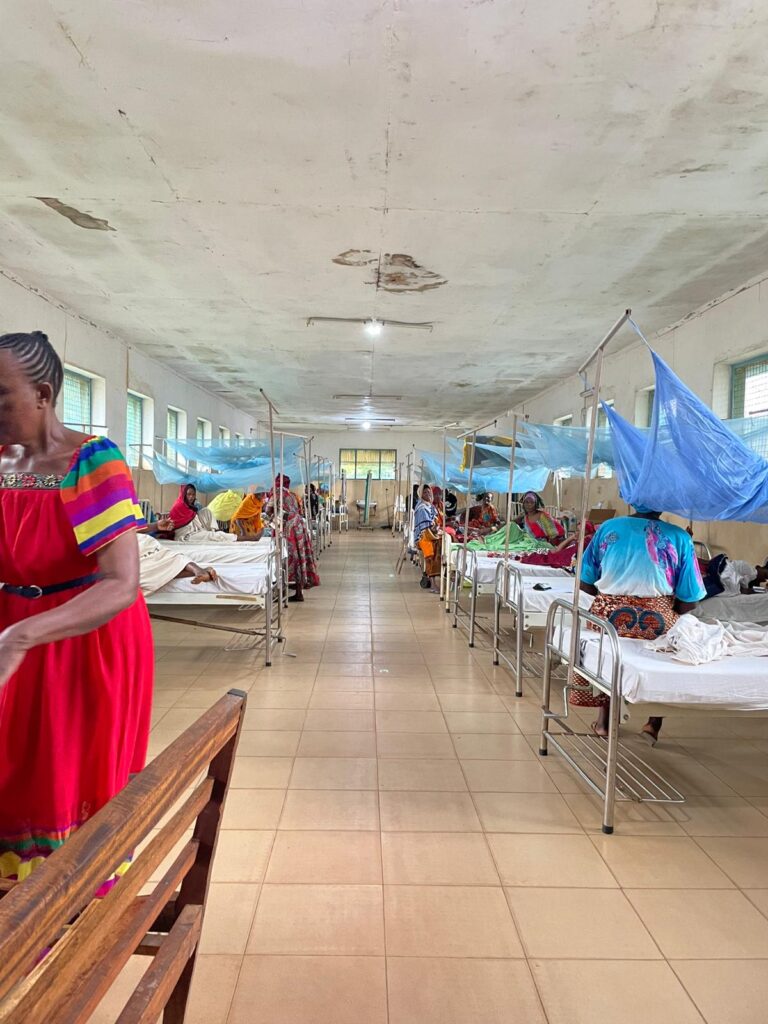
THE COUNTRY:
The United Republic of Tanzania is a country located on the east coast of Central Africa. The name originates from the union of the words “Tanganyika” and “Zanzibar.” The current United Republic of Tanzania was formed on April 26, 1964, when Tanganyika, which had been part of the German colony of German East Africa and later came under British rule at the end of World War I, gained independence on December 9, 1961. The Republic of Zanzibar, which achieved independence from the British crown on December 10, 1963, joined in a single state. The capital is Dodoma, although the most populous city is Dar es-Salaam. There are 120 Bantu groups that make up the majority of Tanzania’s population (61,741,120 inhabitants). Swahili and English are spoken.
Its economy is based on agriculture, which represents half of the GDP. Fishing, especially in Lake Victoria, is also one of the most widespread occupational activities in the country.
The doctor density is 0.03 per 1000 inhabitants. The mortality rate is high, particularly among children due to malaria and among adults due to HIV. 43.74% of the population is concentrated between 0 and 14 years, and the average age is 17.6 years. 14% of children are malnourished. School life expectancy does not exceed 8 years, and child labor accounts for 21% of the population aged 5 to 14.
THE LOCATION:
The cooperation took place in Korogwe, a city of approximately 60,000 inhabitants located in the Tanga region (Northwest Tanzania). To reach it, volunteers flew to Julius Nyerere International Airport, from where they traveled 300 km on sparsely paved roads to reach Korogwe Town Hospital in Magunga (founded in 1952). In Korogwe, there is a significant Catholic congregation, the Congregation of the Sisters of Our Lady of the Mountain of Usambara, created in 1954, playing a crucial role in assisting the local society, including coordinating healthcare through Dr. Avelina Temba, who is also a surgeon. The hospital is a single-story building:
1- New part used for emergencies
2- Old part, which includes:
* Floors divided into male, female, and pediatric sections. All beds have mosquito nets. Each room has a table serving as a nursing control station.
* An office for outpatient consultations where patients were assessed and selected for the interventions we performed.
* A surgical area with 3 operating rooms. The smallest was used by the local medical team for cesarean sections and some other gynecological surgeries. Our group used the other two operating rooms, rudimentary but suitable for the type of surgery we conducted.

THE TEAM:
– Raül Guerrero (Expedition Leader – General and Digestive System Surgery)
– Víctor Parejo (Urology)
– Sara Fernández (Resident Physician in General and Digestive System Surgery)
– Wassim Al Ashtar (Resident Physician in General and Digestive System Surgery)
– Pau Benet (Anesthesia and Resuscitation)
– Anna Casanova (Anesthesia and Resuscitation)
– Marta Guitart (Nurse)
– Núria Soler (Nurse)
– Judit Masramon (Nurse)
– Carlota Andreu (Nurse)

OUR OBJECTIVES:
– Provide medical-surgical assistance to patients in the targeted area who require it.
– Preoperative optimization of patients when deemed appropriate during the preoperative visit.
– Postoperative monitoring of patients and resolution of any complications.
– Ensure proper follow-up once the surgical team returns to the home country.
– Identify unfavorable points for improvement.
– Training of general surgery resident physicians.
– Training of local healthcare professionals through active participation.
– Cultural exchange between the local and European cultures.

THE OPERATING ROOM:
It is worth highlighting some peculiarities of the operating rooms so that those who come after us know what to expect:
– Both operating rooms have a rudimentary but acceptable surgical table. The armrests are two wooden planks.
– General anesthesia cannot be performed. There are two ventilators that, at the time of our mission, were not functioning.
– Between the two operating rooms, there is a handwashing area, but there is no iodine soap or chlorhexidine. Surgical washing had to be done with regular hand soap.

– Electric scalpels can be used, although, as expected, their functionality is not the same as in our environment. The scalpel plates have been reused so many times that they don’t stick, so it would be interesting for future groups to bring some replacements.
– Before our contribution, the hospital had very basic and outdated inventory materials (forceps that don’t grip, needle holders that don’t hold the needle properly, Kocher or Crile forceps that don’t close well, etc.). Regarding sutures, they have some that are rarely used in our environment, such as Catgut®, Dexon®, Nylon, and Silk.
– Regarding lighting: one of the operating rooms has a lamp with a halogen bulb that functions well, although it breaks down repeatedly. The other operating room is equipped with a floor lamp that does not provide much illumination. Both operating rooms have windows that help mitigate the lack or inadequacy of lighting.

– The temperature is quite correct, as there is air conditioning.
– It is not customary to clean the operating room after each surgery. Before starting the day, the hospital staff mops the floor with bleach, but due to the humidity in the environment, most days, we had to start surgeries with a wet floor. Additionally, the smell of the surgical area at the beginning of the day resembled a mixture of chemicals and blood.
– Worth mentioning: the surgical gowns are reusable cloth. They are washed and left to dry outdoors. Since we went during the rainy season, we usually had to put on damp gowns to comply with the surgical schedule for the day.
– It is common to find multiple insects inside the operating room.

– There is a barrier between the surgical area and the rest of the hospital, although it is not always respected. In fact, the stretchers entering the operating room to take out patients come from outside the surgical block.
PATIENTS:
63 patients were operated on (48 men and 15 women) between 3 and 83 years old.
Pediatric patients: 7
After filtering patients in consultations, 6 interventions were canceled due to comorbidity (severe heart or respiratory failure) or non-surgical pathology.
– Inguinal hernias: 30 (22 unilateral, 8 bilateral)
– Recurrent inguinal hernias: 3
– Femoral hernia: 1
– Umbilical hernia: 9
– Epigastric/supraumbilical hernia: 8
– Incisional hernia: 3
– Cryptorchidism: 1
– Cord cyst: 1
– Epididymal cyst: 1
– Lipoma: 2
– Orchiectomy for testicular tumor: 2
Total procedures: 82
Total patients operated on: 63

ADVERSE EFFECTS:
3 scrotal hematomas
1 inguinal hematoma
None of the patients required re-intervention.

DAY TO DAY:
Upon arriving at Dar es-Salaam airport, we collect our luggage, go through passport control, and pay for visas (they accept dollars and euros). Dr. David Siwiti awaits us outside the airport: through a contact of his in customs, we have no problems entering the country with all the material and drugs we are traveling with. After that, we get on a cramped minibus with barely functioning air conditioning to go to Korogwe: we are charged 100 dollars for the round trip, a price we find abusive. After a long 8-hour journey (the distance is 280 km, but dense traffic and dilapidated roads don’t help), we arrive at the Korogwe hotel on October 29th at 23:00. It takes almost 24 hours to reach the destination from Barcelona.
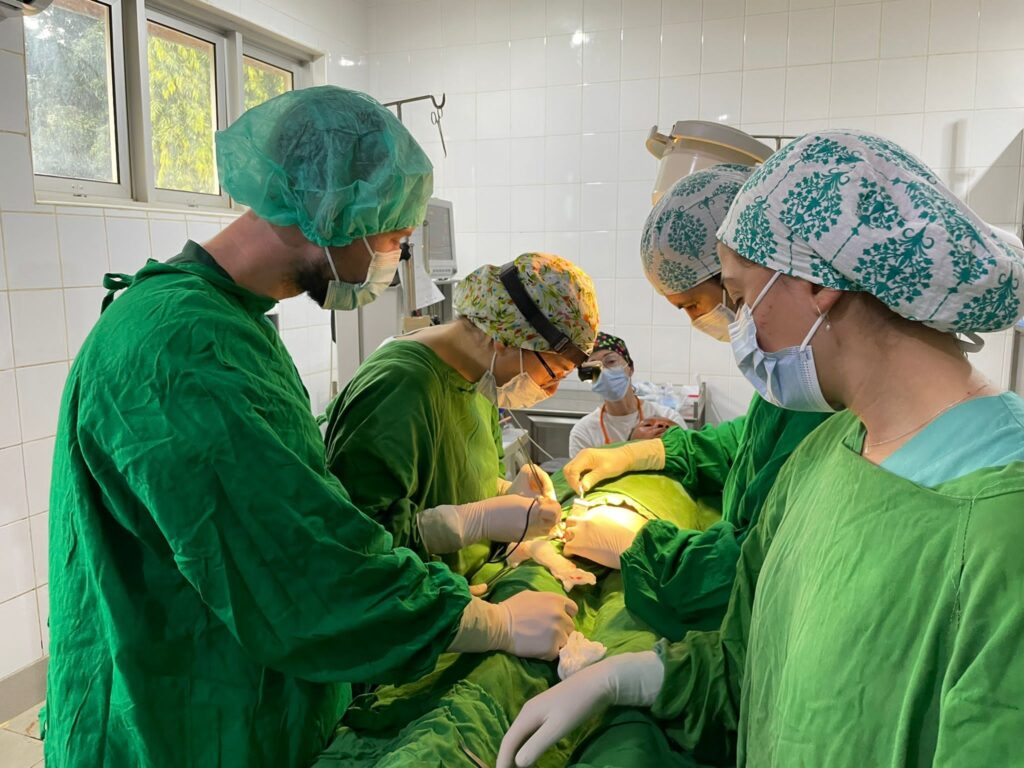
The hotel is more than decent. In addition, the half board we chose includes breakfast and dinner in a buffet style. The Wi-Fi connection is valid for sending text messages but not much more.
The next day, we head to the hospital, and after a brief visit to the center, we proceed to prepare the surgical rooms where we will perform the procedures for the next 5 days. Simultaneously, two doctors from the team reassessed the patients who had been previously selected by the local team.
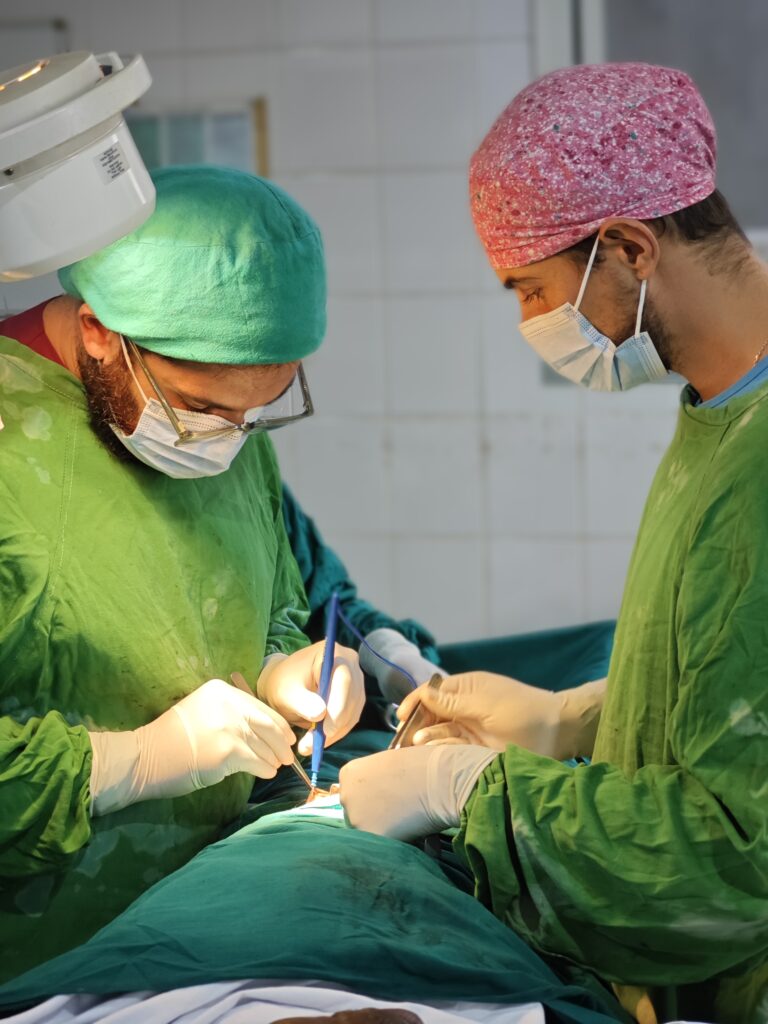
From October 29th to November 3rd, our routine was as follows: breakfast at the hotel at 7:00 am. Transfer to the hospital at 7:30 am. While anesthesiologists and nurses prepare the operating rooms, surgeons check the condition of patients operated on the previous day. After that, surgeries begin in both operating rooms.
The lunch break takes place around 1-2 pm, at the entrance to the surgical block. One cannot be very demanding with the diet since it is based only on chicken and rice. The expenses for lunch were covered by the hospital as well, which we appreciated. We are aware that groups that came before us had to pay high amounts for this reason. We also used the lunchtime to socialize and fraternize with the local staff. Afterward, interventions continue until late afternoon. Some days, the local staff asked us to finish earlier (5 pm), and we agreed.
After arriving at the hotel, there is little usable time left. In the best-case scenario, if there is still sunlight, you can walk around the area and see how teenagers play soccer during sunset or how some adults pick oranges from the trees.
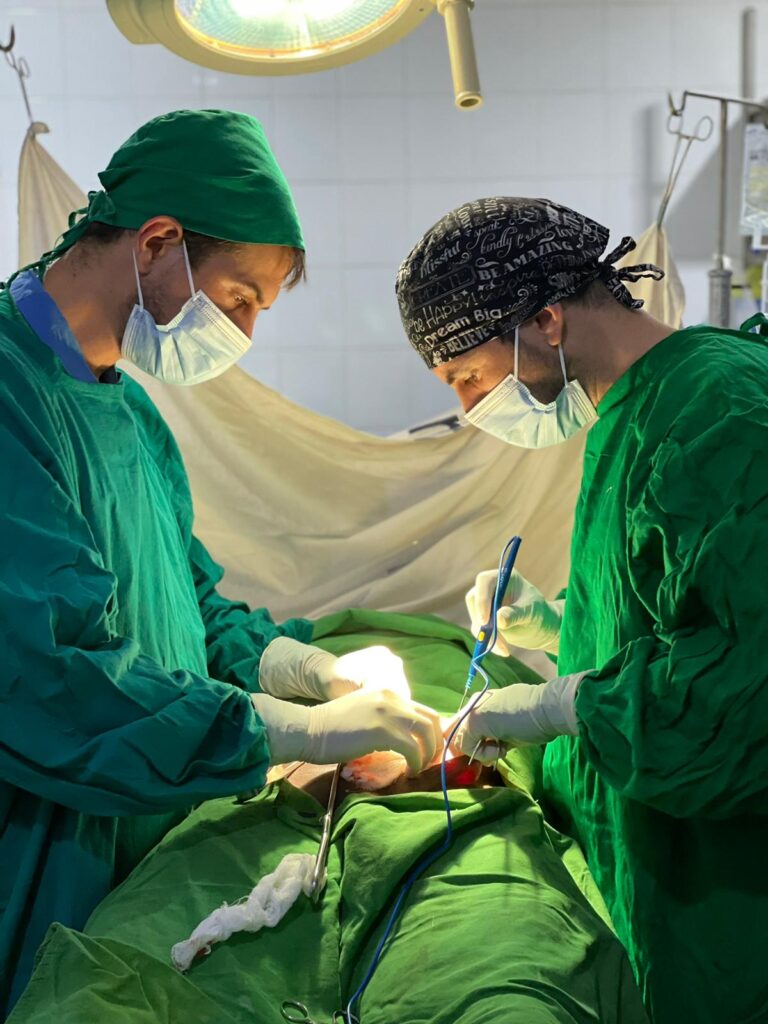
Then, there is only time for a shower, a briefing of the day during dinner, and rest.
It is worth mentioning that in various surgeries, the local medical team collaborated with our group by assisting in surgeries and performing some anesthetic techniques. For us, the teaching of local healthcare staff is almost as important as the patients who undergo surgery. It should be noted that the ultimate goal of cooperation should be that local people can function independently.
As compensation for the intense work, on Saturday, November 4th, thanks to Dr. Siwiti’s management, we visited Mkomazi National Park, where we spotted various animals such as giraffes, gazelles, zebras, rhinoceroses, …
On Sunday, November 5th, we left very early in the minibus for Dar es-Salaam airport for the return to Barcelona.
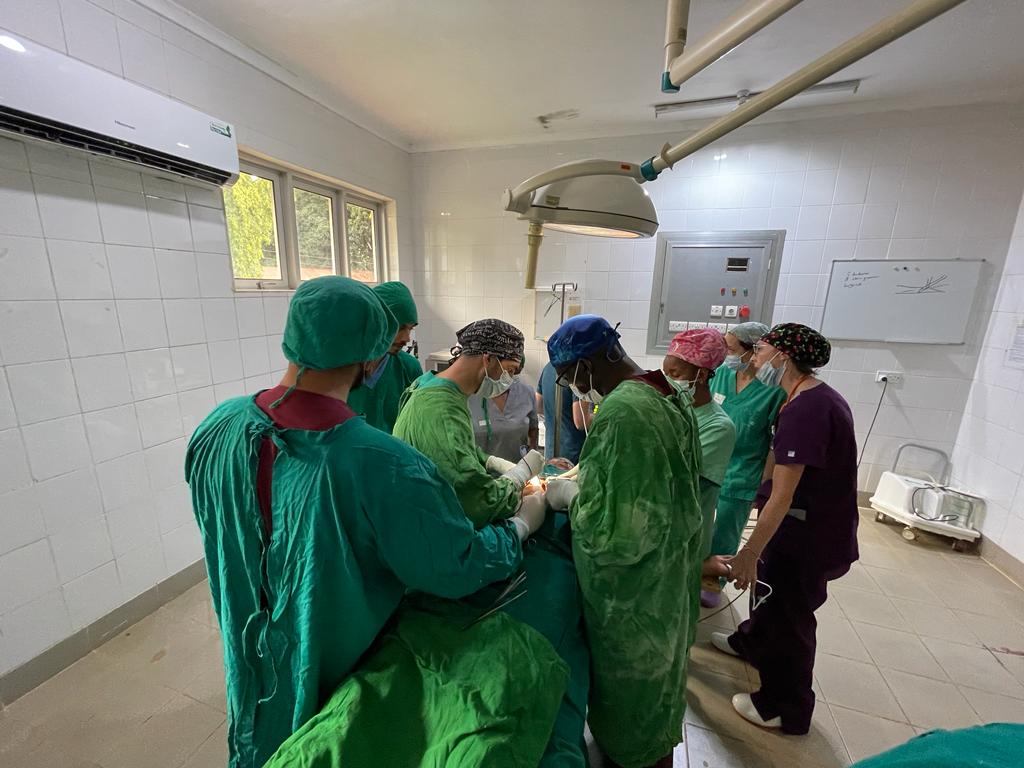
PROS/CONS:
Pros: The local staff is attentive and pleasant, always trying to help and solve problems if they arise.
To improve:
– The circuit and communication for managing/sending data with the local link should improve.
– In the operating room: lighting; scalpel plates; repair the ventilator to be able to perform surgeries under general anesthesia.
– Improve hygienic measures in the operating room.
FINANCIAL REPORT
Below is a breakdown of the individual economic cost associated with the project:
**BREAKDOWN OF INDIVIDUAL PERSONAL EXPENSES:**
– Flight ticket: 837 euros/person
– Visa: 50 euros/person
– Meals and accommodation: 350 euros/person
– Transportation: 100 euros/person
– Standard medical insurance (IATI SEGURO®): 36.90 euros/person
**TOTAL: 1373.9 EUROS/PERSON**
Raül Guerrero

